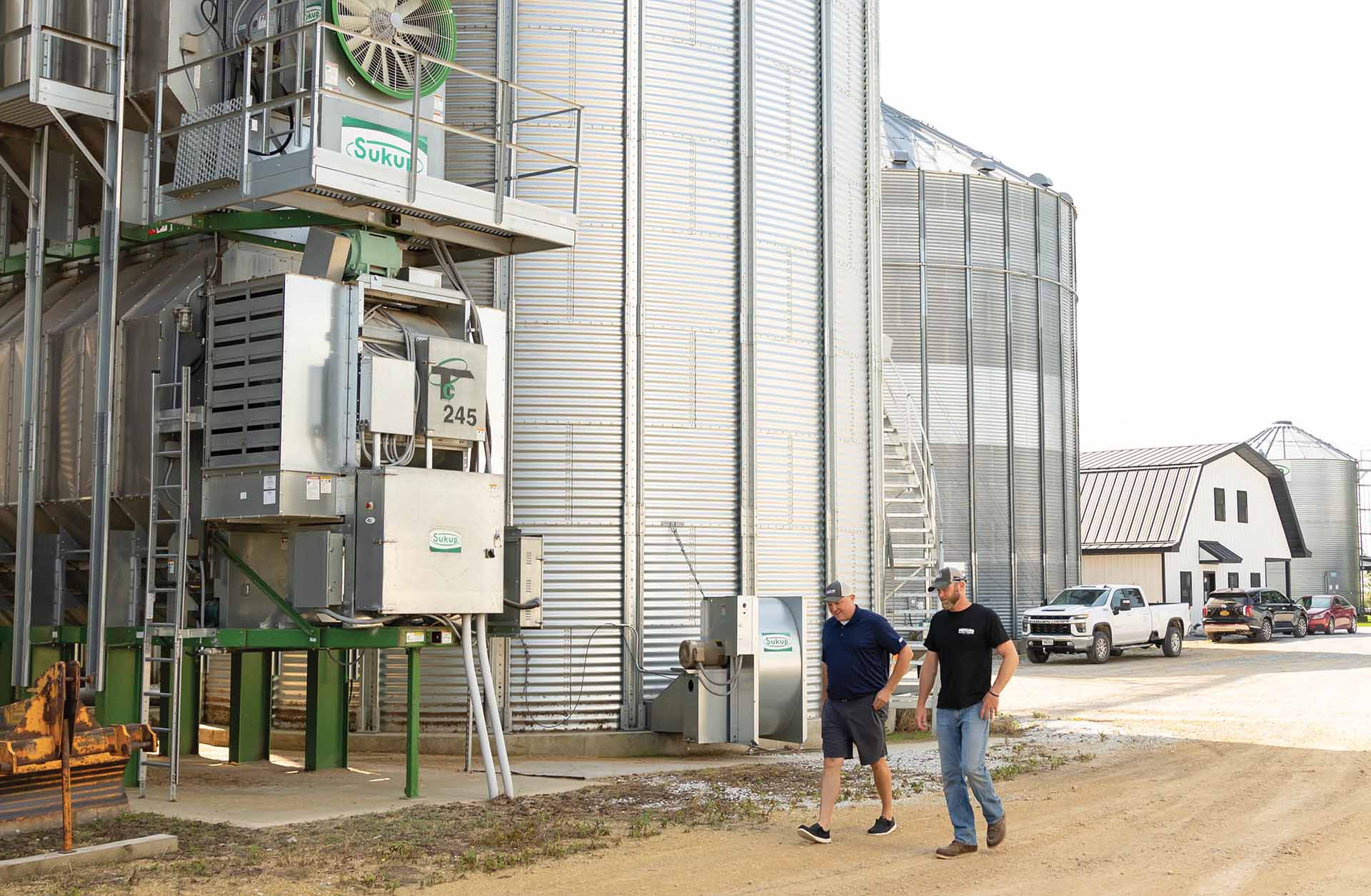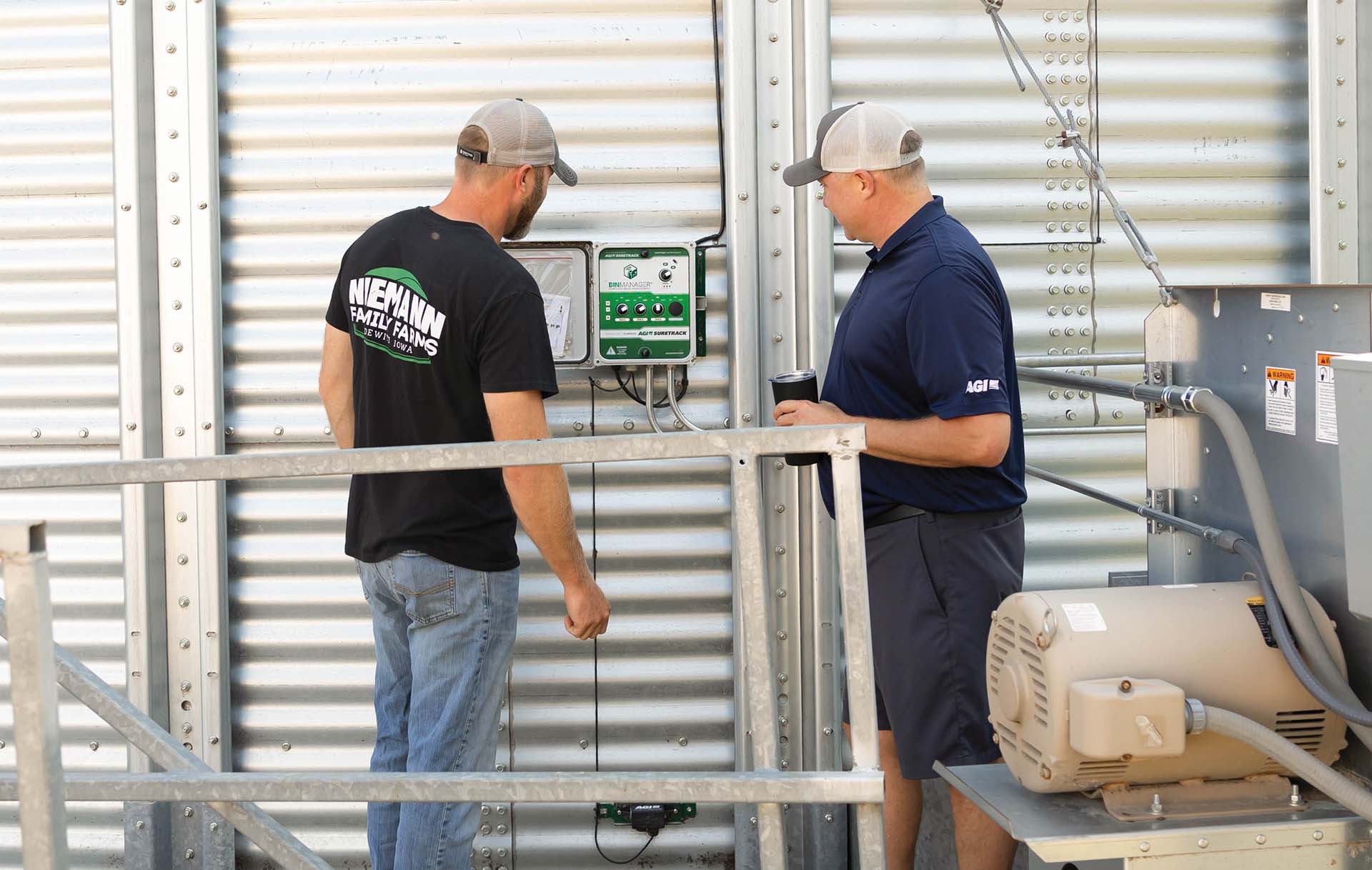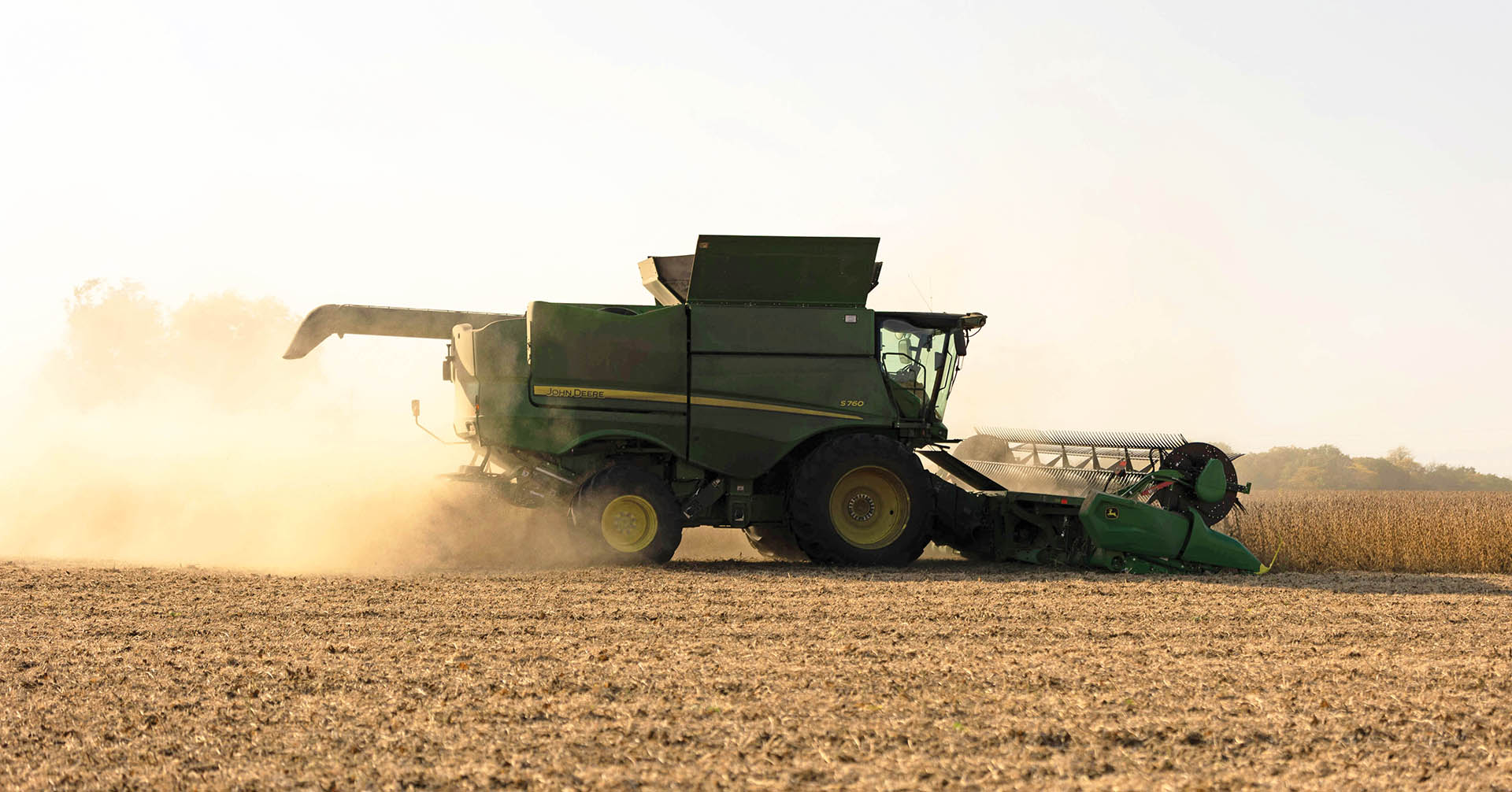
(Photo: Iowa Soybean Association / Joclyn Bushman)
Grain management 101
September 3, 2024 | Kriss Nelson
Taking care of your grain while in storage can have a big impact on your profits
Proper grain storage is the key component between harvest and taking the grain to market. Understanding your grain storage system and ensuring the grain remains in optimal condition are essential for maximizing profits.
“It amazes me how much time and money growers spend on inputs to plant and protect their crops throughout the growing season, only to put it into storage and hope it stays in good condition when it’s hauled to the elevator,” says Andy McGarry, strategic account manager with AGI, which provides grain management solutions to its customers. “The grain inside the bins is essentially the grower’s money so they need to protect it the best they can.”
Like other farmers, Luke Niemann, an Iowa Soybean Association (ISA) farmer member from DeWitt, faces the challenges of managing grain. He has invested in technology to ease his mind and ensure he delivers marketable grain to the elevator.
“Managing grain is not a fun thing. You are crawling up and down grain bins and not always in ideal conditions,” says Niemann. “Bin sites may not always be located right outside your front door, making them a bit more challenging to manage. The technology we have installed is paying off because I can simply open my app on my phone and feel confident my crops are in good condition.”

Pre-Harvest Bin Assessment Checklist
According to McGarry, inspecting your bins thoroughly before harvest is crucial.
1) Perform a maintenance inspection
Evaluate the structural integrity on the inside and outside of bins and top to bottom.
“Inspect the safety, structural integrity, capacity and overall physical condition of bins,” says McGarry. “Look for cracks and holes. Watch for pest infestations. Ensure electrical systems and control boxes run properly. Inspect and lubricate chains and belts and replace anything that shows wear and tear.”
2) Walk the yard and areas around the bins
Clear debris and weeds.
“This is especially important prior to harvest,” says McGarry. “When the fans turn on, you
don’t want to introduce debris and particulate matter into the bin.”
3) Develop a fan plan
Farmers should ensure they have the right aeration system to meet their needs and if it is in working order or requires maintenance.
“Running fans costs too much energy and can also affect grain quality,” says McGarry.
“Think beyond fan type and horsepower. Farmers need to consider bin size, weather,
aeration strategies and grain conditioning goals.”
4) Consider cubic feet per minute per bushel (CFM)
The required airflow rate in CFM to dry soybeans depends on several factors, including the initial moisture content of the soybeans, the desired final moisture content, the depth of the soybean layer, ambient temperature and humidity, and the drying system used.
For grain drying, typical airflow rates range from one to five CFM per bushel, with lower
rates for natural air drying and higher rates for heated air drying.
Here are some general guidelines:
Natural air drying: approximately one to two CFM per bushel. This method relies on ambient air temperature and humidity.
Heated air drying: approximately three to five CFM per bushel. This method uses heated air to increase drying efficiency.
“It’s important to consider that these are general guidelines, and specific requirements may vary based on conditions and drying equipment,” says McGarry. “Consulting with an agricultural extension service or a grain drying expert can provide more precise recommendations tailored to your situation.”
5) Evaluate handling systems
Grain handling systems play a role in how quickly you can load and unload grain during peak times like harvest.
“Check over your permanent and portable material handling equipment and accessories,” says McGarry. “Are they in good working order? Does an auger need to be replaced? Do you need a new accessory to move around the yard, reduce labor, increase capacity and transfer grain?”

Tips for Storing and Selling Soybeans
These tips will prevent spoilage, maintain quality, increase storage life and improve processing efficiency.
“Soybeans stored at the correct moisture content will meet market standards, making them easier to sell and potentially fetch higher prices,” says McGarry. “With the proper aeration systems in place, using a bin monitoring system where you can automate fans to only turn on at opportune times when the weather is right can also rehydrate your soybeans.”
1) Harvest at the correct moisture level
Harvest soybeans when they reach a moisture content of around 13-15%.
“This can be very tough because many growers have mentioned that they might start harvesting their beans at 12-13%, but by the end of the day, they’re at 9-10%,” says McGarry. “Attempting to harvest around the 13-15% level will help reduce the risk of damage during handling and storage.”
2) Avoid overloading storage bins
Be cautious not to overload storage bins with high-moisture soybeans.
“Overloading can hinder proper airflow and lead to uneven drying and spoilage,” says McGarry.
3) Use proper drying techniques
Low-temperature drying methods for soybeans prevent heat damage and maintain quality.
“If harvested at a higher moisture level, soybeans should be dried to 13% for safe storage. Using natural air drying or low-temperature drying methods is best to avoid damaging the beans,” says McGarry.
4) Use proper aeration and ventilation
Use aeration fans to keep air moving through the soybean mass during storage.
“This helps equalize moisture levels and temperature, preventing hotspots and spoilage,” says McGarry.
5) Control temperature
The ideal temperature inside a bin is below 60°F.
“Keep your stored soybeans cool, especially in the spring and summer, to help maintain oil quality,” says McGarry. “Ventilate the top of the bin to reduce solar heating. Lower temperatures also slow the activity of pests and microorganisms, preserving the quality of
the beans.”
6) Monitor storage conditions
Continuously monitor the temperature and moisture levels of stored soybeans.
“Regularly check the moisture content and inspect storage bins for signs of pests and mold. Frequent monitoring helps detect any changes that might require immediate attention,” says McGarry. “You can use a
10-foot probe to collect samples from different depths in the bin to check the moisture content and inspect
your grain.”
7) Handle soybeans gently
High-moisture soybeans are more susceptible to mechanical damage, so farmers should handle soybeans gently during harvest and post-harvest to minimize cracking and breakage.
8) Equalize moisture
Use an aeration fan to move moisture from wetter beans to dry beans and maintain uniform temperature and moisture levels throughout the bin.
“Proper ventilation prevents hot spots and moisture accumulation that could cause marketing losses from moisture variation,” says McGarry.
Storage is all about keeping grain in optimal condition by controlling moisture and temperature or achieving Equilibrium Moisture Content (EMC).
EMC is the moisture content that grain will eventually reach when the air conditions around it remain constant for a period of time. For soybeans, EMC depends on the relative humidity, the air temperature and the grain type.
When drying soybeans in a bin, use fans to circulate dry air through the grain until the moisture content of the soybeans matches the EMC of the air. For example, at a relative humidity of 60–70%, air can dry soybeans to a moisture content of 13–14%. However, if the EMC is higher than the actual moisture content of the soybeans, the beans can become wetter.
On your farm?
Could your grain management system benefit from a digital sensor system that evaluates temperature and moisture conditions inside the bin?
“In-bin automation allows farmers to set targets, automate fans and condition grain during peak times when atmospheric conditions are right to reach goals,” says McGarry.
Digital sensors — which can retrofit to any bin — report grain conditions throughout the bin and alert farmers to hot spots or emerging quality issues.
“I believe that employing technology with sensors to communicate with fans and redistribute moisture back into the soybeans will eventually prove cost effective,” says Niemann. “We might not always harvest soybeans under the best conditions during harvest. In recent years, they have been coming out dry. But our main goal is collecting and storing the crop in the bin at 13%. It will be beneficial if I can reintroduce some moisture into the beans while being confident about it by using monitoring systems in the bins.”

Tips for Harvesting Quality Soybeans
Shane Beck, Iowa Soybean Association (ISA) research agronomist, offers these three tips for setting your combine up for a successful soybean harvest.
1) Match reel speed to ground speed
Ensure the combine’s reel is not spinning too fast and hitting the soybeans. This could cause the soybeans to shatter and hit the ground before they enter the combine. However, you want to be sure you have it going fast enough so it is feeding the soybeans into the head and not just cutting them off, piling soybean up onto the head and not feeding them through.
2) Rotary or cylinder speed
Increase the speed of your rotary or cylinder until you see split soybeans in your grain tank. Once you see those split soybeans, slow down, but not enough that the combine is not threshing the soybeans completely.
Note this speed will change throughout the day, depending on the moisture of the soybeans. As soybeans dry, they could explode out of the pod before you can get them into the combine head.
Continue to monitor the harvested soybeans. If you find too many splits or foreign material in the grain tank, adjust your speed. It may take time to find that balance.
Check behind the combine to ensure you are not throwing too many soybeans out the back of the combine.
3) Calibrate monitors and sensors
Work with your precision equipment dealer to make sure your precision equipment inside the combine is operating correctly. You can also use scale tickets to help calibrate your yield monitor.
It is also wise to double-check that your moisture sensor is working. You can do this by comparing your findings to a sample taken into the local coop.
Moisture is money
With an ideal soybean moisture at 13%, Tom Adam, ISA board secretary and farmer from Keokuk says he is mindful of moisture content while harvesting to ensure he is delivering a high-quality soybean to market.
“Discounts can be very expensive at the elevator, and you don’t want to give away a lot of yield from harvesting a dry or too wet soybean,” says Adam, adding on a hot and windy day he has seen soybeans dropping in moisture nearly 5% in one day.
Green stem
In the past few years, Adam says he has become more aware of Green Stem Disorder (GSD) in soybeans.
According to the Soybean Research and Information Network, GSD is a disorder in which stems remain green and moist well past the point when pods and seeds are fully ripe and dry.
“In recent years I have had a lot of green stems in my soybeans at harvest,” says Adam. “The green fodder is harder to get through the combine.”
GSD complicates soybean harvest by significantly increasing the difficulty in cutting the affected plants. As a result, combine operators often must reduce ground speed and increase engine power, resulting in poor fuel efficiency and increased harvest time. It also increases wear and tear on combines. Harvest delays also increase the chances of lodging, shattering and seed decay that can reduce grain yield and quality.
Factors linked to GSD include stink bug feeding, late herbicide application, fungicide application, soybean infection, and late planting and/or emergence.
“There may be a lot of leaves and petioles on the bottom of the soybean plants, but the soybeans are measuring at optimal soybean moisture levels,” says Beck. “Don’t be afraid to take a test run, see how they thresh through the combine. They might not look ready, but often they are.”
Back